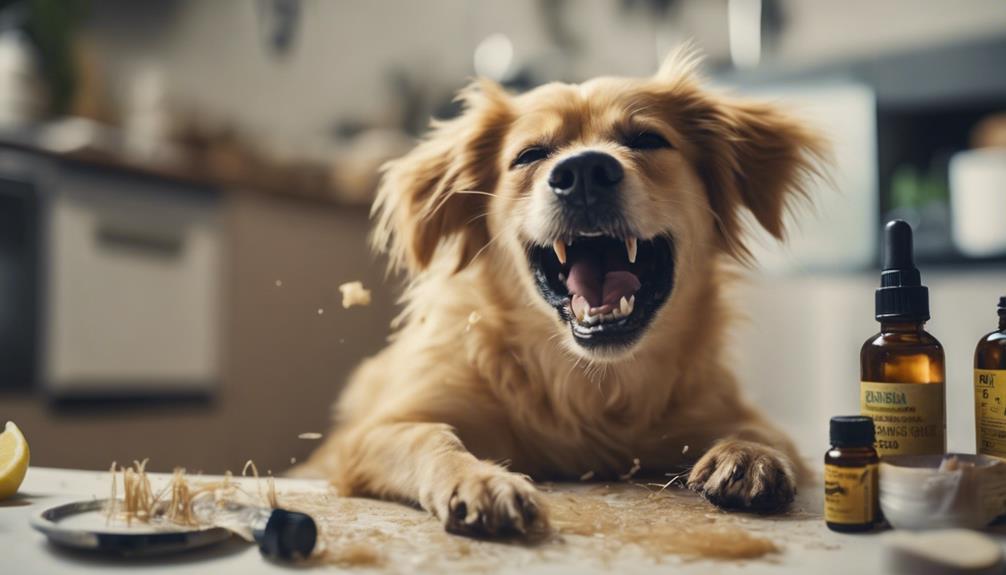Within the realm of canine care, the presence of dog fleas is a persistent concern that warrants attention from pet owners. These pesky parasites not only cause discomfort to our furry companions but also pose health risks to both pets and humans.
As dog lovers strive to create safe and healthy environments for their animals, understanding the nuances of flea management becomes paramount. From the subtle signs of infestation to effective treatment methods, a proactive approach is key to combating these unwanted guests.
In exploring the strategies for tackling dog fleas head-on, one can uncover valuable insights to safeguard their pet and household from the challenges posed by these resilient pests.
Key Takeaways
- Dog fleas cause itching and discomfort through biting and infestations.
- Fleas can be found on dogs, in homes, and even on humans.
- Effective treatment includes oral medications, shampoos, and flea collars.
- Flea control in homes involves vacuuming, washing fabrics, and professional help if needed.
Signs of Fleas in Dogs
In assessing the presence of fleas in dogs, vigilance towards behavioral changes such as scratching, biting, or chewing is paramount. These signs often indicate a potential flea infestation that requires prompt attention. Dogs may exhibit increased scratching, particularly around the neck, ears, and tail areas.
Excessive biting or chewing of the skin, especially in localized areas, can also be indicative of fleas. Additionally, dogs with fleas may become restless or agitated due to the discomfort caused by these parasites.
Observing these behavioral changes carefully and taking appropriate action, such as inspecting the dog's skin for signs of fleas or flea dirt, is crucial in addressing and managing flea infestations effectively.
Identifying Fleas on Your Dog
When examining your dog for signs of fleas, a thorough inspection of its fur and skin is essential to identify these parasites. Look for signs such as excessive scratching, biting, or chewing. Additionally, check for tiny brown spots on your dog's skin, which could be fleas or flea dirt.
Flea dirt, which resembles tiny black specks, may turn reddish-brown when dampened. Be especially vigilant in areas where fleas are commonly found, such as yards, nature walks, and dog parks. If you suspect your dog has fleas, it is crucial to address the issue promptly to prevent further infestation and discomfort for your pet.
Treating Dog Fleas Effectively

Effective treatment of dog fleas involves targeting and eliminating fleas at all life stages to ensure thorough eradication and prevention of re-infestation. There are various methods for treating dog fleas effectively.
Oral flea medications can provide protection for up to 12 weeks, while topical medications can kill adult fleas and eggs for up to 30 days. Shampoos and flea baths are useful for treating active infestations, and flea collars emit pesticides to repel fleas and ticks.
It is essential to follow the instructions carefully when using these treatments to maximize their effectiveness. By addressing fleas comprehensively and utilizing appropriate products, pet owners can successfully eliminate these pesky parasites and ensure the well-being of their dogs.
Preventing Future Flea Infestations
To prevent future flea infestations, proactive measures must be taken to safeguard the environment in which pets reside. Here are three key steps to help prevent fleas from infesting your home:
- Regularly treat pets with flea preventatives: Use oral medications, topical treatments, flea collars, or shampoos recommended by your veterinarian to keep fleas at bay.
- Maintain a clean living environment: Vacuum carpets, wash pet bedding regularly, and keep outdoor areas where pets play free from debris and overgrowth.
- Consider professional pest control services: If flea infestations persist despite your efforts, seek help from professional exterminators to effectively eliminate fleas from your home.
Impact of Fleas on Pets

Pets affected by flea infestations can experience various detrimental consequences to their health and well-being. Fleas can cause irritation, allergic reactions, and transmit diseases to pets, leading to discomfort and potential health complications. Additionally, constant itching and scratching due to flea bites can result in skin infections and hair loss. Moreover, flea infestations can lead to anemia, especially in young or small pets, due to blood loss from flea feeding. To highlight the impact of fleas on pets, the following table illustrates common health issues caused by flea infestations:
| Health Issues Caused by Fleas | Description |
|---|---|
| Skin Irritation | Constant scratching and biting |
| Allergic Reactions | Allergic responses to flea saliva |
| Disease Transmission | Potential spread of diseases |
| Skin Infections | Secondary infections from scratching |
| Anemia | Blood loss leading to anemia |
Addressing Fleas in Your Home
Addressing flea infestations in your home requires thorough and systematic cleaning to eliminate these persistent parasites. Here are three essential steps to help you tackle fleas in your living space:
- Vacuuming: Regularly vacuum carpets, rugs, and furniture, focusing on areas where your pets spend time. Dispose of the vacuum bag immediately after cleaning to prevent fleas from re-infesting your home.
- Washing: Launder your pet's bedding, blankets, and any fabrics they frequently come into contact with in hot water. This will help kill flea eggs and larvae that may be hiding in these items.
- Decluttering: Clear out cluttered areas where fleas can hide, such as piles of clothes or unused furniture. Removing these hiding spots makes it easier to spot and eliminate fleas.
DIY House Flea Treatment

Thorough cleaning and targeted treatments are essential components of an effective DIY approach to eradicating fleas from your home. Start by vacuuming thoroughly, focusing on carpets, rugs, and furniture where fleas and their eggs may hide. Launder all fabrics your dog has come into contact with, including bedding and upholstery covers. Utilize fog treatments specifically designed to combat fleas, following the instructions meticulously to ensure safety and efficacy. If the infestation persists despite DIY efforts, consider seeking assistance from professional exterminators. Remember, consistency is key in eliminating fleas from your living space.
| DIY House Flea Treatment | Description | Benefits |
|---|---|---|
| Thorough Vacuuming | Remove fleas and eggs from carpets | Targets flea hotspots |
| Launder Fabrics | Wash dog bedding and upholstery | Eliminates flea larvae and eggs |
| Fog Treatment | Specialized treatment for fleas | Reaches hidden areas |
| Professional Exterminators | Expert help for severe infestations | Ensures comprehensive eradication |
Professional Flea Extermination Options
To effectively combat persistent flea infestations beyond DIY efforts, homeowners may seek professional flea extermination services for comprehensive eradication. Professional flea exterminators offer specialized treatments and expertise to eliminate fleas effectively. Here are three key options homeowners can consider:
- Fumigation: Professional exterminators use fumigation techniques to eradicate fleas from the entire home, including hard-to-reach areas where fleas may hide.
- Targeted Treatments: Professionals can apply targeted insecticides to specific areas where fleas are most prevalent, ensuring thorough elimination without harming pets or humans.
- Follow-up Inspections: Professional exterminators often provide follow-up inspections to ensure that the flea infestation has been successfully eradicated and to address any lingering issues promptly.
Additional Resources for Flea Control

For comprehensive guidance on managing and preventing flea infestations, a range of valuable resources are available to assist pet owners in their efforts. Veterinarians are a primary resource for tailored flea control plans, including prescription medications and advice on environmental management.
Online platforms such as reputable pet health websites and forums provide insights on flea prevention, treatment options, and reviews on flea control products. Pet stores offer a variety of over-the-counter flea control products, including shampoos, sprays, collars, and spot-on treatments.
Additionally, there are educational materials like brochures, books, and instructional videos that can enhance understanding of flea control measures and help maintain a flea-free environment for pets and their owners.
Conclusion
In conclusion, understanding the signs of flea infestations in dogs, as well as implementing effective treatment and prevention strategies, is essential for maintaining the well-being of our canine companions.
By being proactive in addressing flea issues, pet owners can protect their pets and living spaces from the harmful effects of these persistent parasites.
It is crucial to remain vigilant and take necessary steps to control fleas to ensure a healthy and comfortable environment for both pets and humans.




